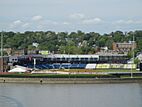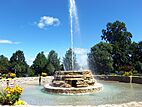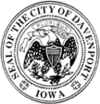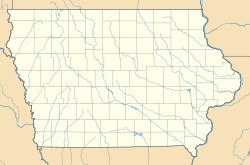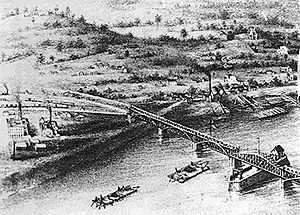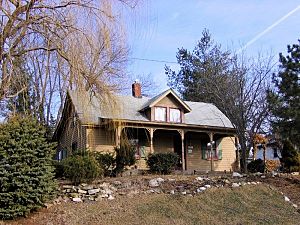Davenport, Iowa facts for kids
Quick facts for kids
Davenport
|
|||
|---|---|---|---|
|
|||
| Nickname(s):
Iowa's Front Porch
|
|||
| Motto(s):
Working together to serve you
|
|||
| Country | United States | ||
| State | Iowa | ||
| County | Scott | ||
| Settled | May 14, 1836 | ||
| Incorporated | January 25, 1839 | ||
| Named for | George Davenport | ||
| Government | |||
| • Type | Mayor–council | ||
| Area | |||
| • City | 65.92 sq mi (170.73 km2) | ||
| • Land | 63.80 sq mi (165.23 km2) | ||
| • Water | 2.12 sq mi (5.50 km2) | ||
| Elevation | 580 ft (180 m) | ||
| Population
(2020)
|
|||
| • City | 101,724 | ||
| • Rank | 3rd in Iowa (US: 296th) |
||
| • Density | 1,594.55/sq mi (615.65/km2) | ||
| • Urban | 285,211 (US: 142nd) | ||
| • Urban density | 2,114.9/sq mi (816.6/km2) | ||
| • Metro | 384,324 (US: 147th) | ||
| • CSA | 474,019 (US: 90th) | ||
| Demonym(s) | Davenporter | ||
| Time zone | UTC−6 (CST) | ||
| • Summer (DST) | UTC−5 (CDT) | ||
| ZIP Codes |
52801–52809
|
||
| Area code | 563 | ||
| FIPS code | 19-19000 | ||
| GNIS ID | 455799 | ||
Davenport is a city in Iowa, United States. It's the main city in Scott County. You can find it along the Mississippi River, right on Iowa's eastern edge.
Davenport is the biggest city in the Quad Cities area. This area is home to over 384,000 people. In 2020, Davenport itself had a population of 101,724. This makes it Iowa's third-largest city, after Des Moines and Cedar Rapids.
The city was founded on May 14, 1836, by Antoine Le Claire. He named it after his friend, George Davenport. From the 1860s to the 1980s, Davenport grew a lot. It had many different industries, like making trains and car parts.
Davenport is known for its location on the Mississippi River. Because of this, it sometimes experiences floods. Unlike some nearby cities, Davenport doesn't have a tall, modern flood wall.
The city is home to two main universities: St. Ambrose University and Palmer College of Chiropractic. The very first chiropractic adjustment happened at Palmer College. Davenport also hosts fun events like the Mississippi Valley Blues Festival and the Bix Beiderbecke Memorial Jazz Festival. There's even a famous 7-mile race called the Bix 7.
Sports fans can cheer for the Quad Cities River Bandits, a minor-league baseball team. Davenport also has over 50 parks and more than 20 miles of paths for biking and walking.
Contents
- Davenport's Past: A Look at Its History
- Davenport's Location and Environment
- Davenport's Neighborhoods and Landmarks
- People and Economy
- Fun Things to Do: Arts, Culture, and Sports
- Parks and Outdoor Activities
- Learning in Davenport: Schools and Colleges
- Media and Communication
- How Davenport Moves: Transportation
- Important People from Davenport
- Davenport's Sister Cities
- Images for kids
- See also
Davenport's Past: A Look at Its History
Early Days and Native American Tribes
The land where Davenport now stands was first home to Native American tribes. These included the Sauk, Meskwaki, and Ho-Chunk (Winnebago) tribes. In the 1700s, France claimed this area. Later, it became part of the United States.
In 1805, Lieutenant Zebulon Pike was the first U.S. representative to visit this part of the Upper Mississippi River. He even camped where Davenport is today.
The Black Hawk Purchase and City Founding
In 1832, the U.S. defeated some Sauk, Meskwaki, and Kickapoo people in the Black Hawk War. After the war, the U.S. bought a large area of land in eastern Iowa. This deal was called the Black Hawk Purchase.
The purchase was signed on the spot where Davenport is now. Antoine Le Claire, who helped translate, later founded Davenport on May 14, 1836. He named it after his friend, Colonel George Davenport. The city officially became a town on January 25, 1839.
Becoming the County Seat
Scott County was created in 1837. Davenport and a nearby town, Rockingham, both wanted to be the county seat. This meant being the main town for the county government.
After a few close elections, Davenport finally won. To make sure there were no more arguments, Davenport quickly built the first county courthouse.
Railroads and River Travel
In 1856, the Rock Island Railroad built the first railroad bridge across the Mississippi River. This bridge connected Davenport to Rock Island, Illinois. It made travel and trade with Chicago much easier.
Steamboat companies saw railroads as a threat. Soon after the bridge was built, a steamboat captain crashed his boat into it on purpose. The railroad company was sued, and Abraham Lincoln was their lawyer. The case ended without a clear winner, but the bridge was fixed. Eventually, the United States Supreme Court said it was okay to build bridges over rivers.
Growth and Challenges
Before the American Civil War, Davenport became Iowa's first military headquarters. Several army camps were set up here to help the Union.
In 1895, the Davenport City Hall was built for $100,000. In the 1920s, Davenport's skyline started to grow with new buildings like the Kahl Building.
During the Great Depression in the 1930s, many people in Davenport struggled. A shantytown, or poor settlement, grew along the river. But things improved when people found work with government programs.
Davenport had a big economic boom during and after World War II. Many companies, like Oscar Mayer and Ralston Purina, built factories here. The city also grew by adding smaller towns nearby.
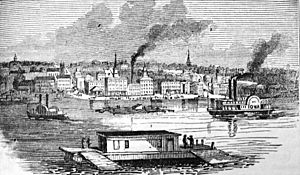
However, in the late 1970s and 1980s, Davenport faced tough times. Many jobs were lost as industries changed. For example, the Caterpillar plant closed.
By the 1990s, the city began to recover. In the early 2000s, downtown Davenport was revitalized. Projects like fixing Modern Woodmen Park and building the Davenport Skybridge helped. The Figge Art Museum was also built.
Davenport's Location and Environment
Where is Davenport?
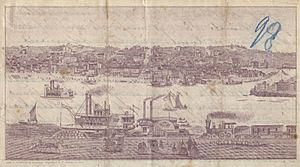
Davenport is about 170 miles west of Chicago. It's also about 170 miles east of Des Moines, Iowa's capital. The city is surrounded by farmland outside the Quad Cities area.
The city sits on the banks of the Mississippi River. At this point, the river flows from east to west, which is unusual for the Mississippi. The city then slopes up a hill from the river.
Dealing with Flooding
Davenport often gets attention for its seasonal flooding from the Mississippi River. It's the largest city on the Mississippi without a permanent flood wall or levee. Residents prefer to keep open access to the river for parks and views.
To manage floods, new buildings in flood-prone areas must be built higher up or protected by walls. For example, the Figge Art Museum is built to be flood-proof.
Davenport's Climate
Davenport has a humid continental climate. This means summers are warm and humid. Winters are cold and often windy, with snow from November to February. The average snowfall is about 30.7 inches per year.
January is usually the coldest month, and July is the warmest. The highest temperature ever recorded was 111°F in 1936. The lowest was -29°F in 2009. Weather can change quickly every few days.
While small tornadoes have happened, a major tornado has never hit Davenport. Flooding, however, is a common issue. During the Great Flood of 1993, the river rose almost 8 feet above flood stage.
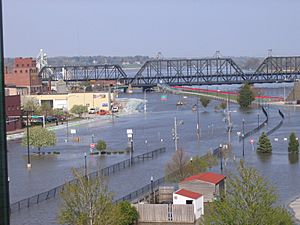
Major floods close roads and cause traffic problems. The effects can last a long time. For instance, after the 2008 flood, Credit Island park was closed for over five months for cleanup. Duck Creek, a stream in Davenport, can also have flash floods. In 1990, severe storms caused flash flooding that killed four people.
Davenport's Neighborhoods and Landmarks
Exploring Davenport's Areas
Davenport has many neighborhoods, some dating back to the 1840s. The city can be divided into five main areas: downtown, central, east end, near north and northwest, and west end. You can see many types of architecture here, like Victorian and Queen Anne styles. Many early German settlers lived in these neighborhoods.
The east side of the city has always had more expensive homes. These areas offer great views of the river. Lindsay Park, in The Village of East Davenport, was once used for Civil War soldiers' parades.
In contrast, the central and west neighborhoods were home to many working-class German families. The Hamburg Historic District has some of the most important historic homes in the old German areas.
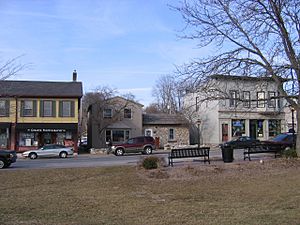
The Vander Veer Park Historic District is in central Davenport. It's centered around Vander Veer Botanical Park, a large park with a botanical garden and a fountain. This park was designed like New York City's Central Park. It's surrounded by large, beautiful homes built around 1900.
Downtown Highlights
Today, the eastern side of Davenport still has many of the city's higher-end houses. The Village of East Davenport, often called "The Village," now has Lindsay Park and small shops.
Downtown Davenport has many interesting places. These include the Davenport Public Library, the Davenport Skybridge, and the Figge Art Museum. You can also find the River Music Experience, the Putnam Museum, and the RiverCenter/Adler Theater.
Modern Woodmen Park is downtown, where the Quad City River Bandits baseball team plays. The Centennial Bridge also connects downtown Davenport to Rock Island, Illinois. The Freight House, a former train building, now has local businesses.
Davenport's cultural spots include the Figge Art Museum, which focuses on Midwest art. The Putnam Museum was founded in 1867. The Quad City Symphony Orchestra is also based here. The German American Heritage Center is located near the Centennial Bridge.
Uptown and Beyond
Uptown Davenport has historic places like the Iowa Soldiers' Orphans' Home, which cared for children after the Civil War. Ambrose Hall was the first building of St. Ambrose University.
For entertainment, the Great Mississippi Valley Fairgrounds hosts fairs and other events. NorthPark Mall is the city's main shopping center. Brady Street Stadium hosts high school and university football games.
Davenport has many parks. Credit Island park has a bike path, baseball fields, and fishing. Vander Veer Botanical Park has beautiful flower displays, a walking path, and a fountain. The Stampe Lilac Garden is in Duck Creek Park.
People and Economy
Davenport's Population
Davenport's population was 101,724 in 2020. The city has a mix of different backgrounds.
| Race / Ethnicity (NH = Non-Hispanic) | Pop 2000 | Pop 2010 | Pop 2020 | % 2000 | % 2010 | % 2020 |
|---|---|---|---|---|---|---|
| White alone (NH) | 79,972 | 76,404 | 72,246 | 81.3% | 76.65% | 71.02% |
| Black or African American alone (NH) | 8,917 | 10,465 | 11,833 | 9.1% | 10.50% | 11.63% |
| Native American or Alaska Native alone (NH) | 303 | 270 | 223 | 0.3% | 0.27% | 0.22% |
| Asian alone (NH) | 1,947 | 2,140 | 2,224 | 2.0% | 2.15% | 2.19% |
| Pacific Islander alone (NH) | 21 | 36 | 35 | 0.02% | 0.04% | 0.03% |
| Other race alone (NH) | 138 | 128 | 292 | 0.1% | 0.13% | 0.29% |
| Mixed race or Multiracial (NH) | 1,793 | 2,987 | 5,890 | 1.8% | 3.00% | 5.79% |
| Hispanic or Latino (any race) | 5,268 | 7,255 | 8,981 | 5.4% | 7.28% | 8.83% |
| Total | 98,359 | 99,685 | 101,724 | 100.00% | 100.00% | 100.00% |
Jobs and Businesses
Davenport's biggest job sector is manufacturing, with over 7,600 jobs. John Deere is the largest single employer in the Quad Cities, with 7,200 workers. Its headquarters are in Moline.
Other big employers in Davenport include Genesis Health System, Trinity Regional Health System, and the grocery store Hy-Vee. The Davenport Community School District also employs many people.
Davenport is home to the department store Von Maur, which has 24 stores. It's also where Lee Enterprises is based. This company publishes many newspapers and online sites across 23 states.
Fun Things to Do: Arts, Culture, and Sports
Festivals and Events
The Bix Fest is a three-day music festival. It celebrates Bix Beiderbecke, a famous jazz musician from Davenport. The festival started in 1971.
The annual Bix 7 is a 7-mile road race held in July. It started in 1975 with 84 runners. Now, between 12,000 and 18,000 people take part!
In late July or early August, the Great Mississippi Valley Fair takes place. This six-day event has concerts, carnival rides, and food. Other local events include River Roots Live and the Beaux Arts Fair.
Awards for Livability
Davenport, along with Rock Island, Illinois, won the 2007 City Livability Award. This award from the U.S. Conference of Mayors recognized their efforts to make the cities safer and more enjoyable places to live.
Sports Teams
Davenport and the Quad Cities have several sports teams. The Quad Cities River Bandits baseball team plays at Modern Woodmen Park in downtown Davenport.
The TaxSlayer Center in Moline, Illinois, is home to the Quad City Steamwheelers indoor football team and the Quad City Storm hockey team. Davenport high schools compete in the Mississippi Athletic Conference for sports.
Parks and Outdoor Activities
Davenport has over 50 parks and recreational trails. Credit Island is a large 450-acre park along the Mississippi River. It has bike paths, baseball fields, and tennis courts.
Fejervary Park has a pool and is visited by about 20,000 people each year. Junge Park has baseball and softball fields, volleyball, and basketball courts. LeClaire Park is right on the Mississippi River. It hosts many summer events, including music festivals. Vander Veer Botanical Park is known for its beautiful flowers.
The city has two main trails for biking or walking. The Duck Creek Parkway runs for 8.26 miles. The Riverfront Parkway stretches 4.75 miles along the Mississippi River. Both trails continue into Bettendorf.
Davenport also has three public golf courses. For river fun, the Channel Cat boat offers rides across the Mississippi. It connects bike paths on both the Iowa and Illinois sides of the river.
Learning in Davenport: Schools and Colleges
Davenport public schools serve nearly 14,500 students. The Davenport Community School District is the fourth-largest school district in Iowa. Davenport has four public high schools: Central, West, Mid City, and North. There is also one private high school, Assumption.
The city has six public middle schools and 23 public elementary schools. One middle school, Sudlow, is named after Phebe Sudlow. She was the first female public school superintendent in the United States, serving Davenport from 1874 to 1878.
Davenport has four colleges and universities. Saint Ambrose University, founded in 1882, is the oldest. Other schools include Kaplan University, Palmer Chiropractic College, and Hamilton Technical College. Palmer College is famous as the first chiropractic school in the world.
Media and Communication
Davenport has two main daily newspapers: the Quad-City Times and The Dispatch/Rock Island Argus. There is also a free newspaper called the River Cities' Reader.
All four major TV networks have stations in the area. KWQC (NBC) and KLJB (Fox) are in Davenport. WHBF (CBS) is in Rock Island, and WQAD (ABC) is in Moline.
Radio station WOC started broadcasting in 1922. In 1933, future president Ronald Reagan worked there as an announcer.
How Davenport Moves: Transportation
Three major interstate highways serve Davenport: Interstate 80, Interstate 280, and Interstate 74. Interstate 88 serves the Illinois Quad Cities and goes east to Chicago.
Other important roads include U.S. Route 6, U.S. Route 61, and U.S. Route 67. U.S. 67 crosses into Illinois using the Rock Island Centennial Bridge. Davenport is connected to Illinois by three bridges over the Mississippi River. These are the Government Bridge, the Centennial Bridge, and the I-280 Bridge.
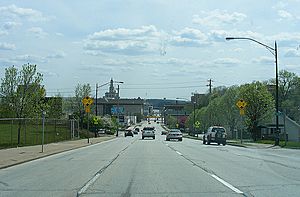
For air travel, Davenport Municipal Airport is for smaller planes. The annual Quad City Airshow is held there. The Quad City International Airport in Moline, Illinois, is the closest airport for commercial flights.
Amtrak train service does not currently stop in Davenport. The closest station is about 50 miles away in Galesburg, Illinois. There are plans to bring Amtrak service to the Quad Cities, with a new line from Moline to Chicago.
Davenport has a bus service called CitiBus. It covers about 30 square miles of the city. CitiBus connects with bus systems in Bettendorf and the Illinois Quad Cities.
Davenport is also known for its "truck-eating bridge." This is a set of railroad bridges that cross over U.S. Route 61. On average, 12 semi-trucks hit these bridges each year, often causing a lot of damage to the trucks!
Important People from Davenport
Many notable people have come from Davenport.
- Sports: Michael Nunn was a boxing champion. Roger Craig and Julian Vandervelde played in the NFL. Ricky Davis played in the NBA. Robbie Lawler is a UFC champion. Seth Rollins is a professional wrestler.
- Music: Jazz musician Bix Beiderbecke is from Davenport. Guitarist and vocalist John Kadlecik also grew up here.
- Arts: Artist Isabel Bloom created decorative concrete figurines. Actors include Lara Flynn Boyle and Sue Lyon.
- Inventors: Otto Frederick Rohwedder, who invented mass-produced sliced bread, grew up in Davenport.
Davenport's Sister Cities
Davenport has special connections with cities around the world:
 Kaiserslautern, Germany (since 1960)
Kaiserslautern, Germany (since 1960) Ilhéus, Brazil (since 2005)
Ilhéus, Brazil (since 2005) County Carlow, Ireland (since 2006)
County Carlow, Ireland (since 2006)
Davenport also has friendly relations with:
Images for kids
-
Picture of Davenport in 1865; on the right is the Steamboat Iowa, which appears in the Seal of Iowa.
-
Lithograph of Davenport from a letter-head dating to 1868
-
Flooding on April 30, 2008. The red line (at the top right) indicates where the Mississippi River should be. The picture was taken from the Skybridge.
-
One of Davenport's oldest neighborhoods, the Village of East Davenport, is full of small specialty shops.
-
The Redstone Building was originally the longtime home of the Petersen Harned Von Maur flagship store and is now home of the River Music Experience.
-
The Rock Island Centennial Bridge connects Downtown Davenport with Downtown Rock Island, Illinois
-
Heading into Downtown Davenport on Harrison Street (US 61) South Bound.
See also
 In Spanish: Davenport (Iowa) para niños
In Spanish: Davenport (Iowa) para niños






